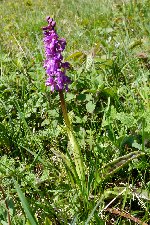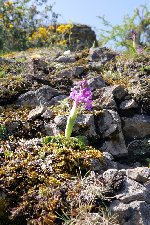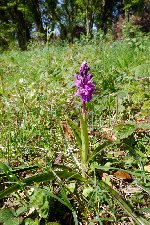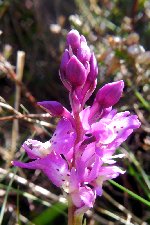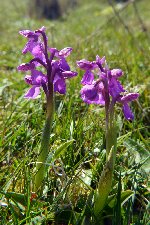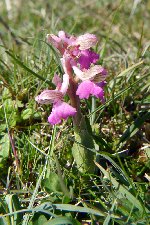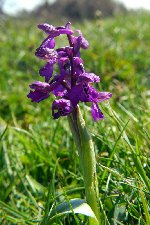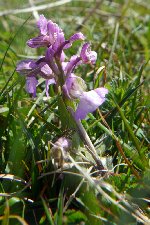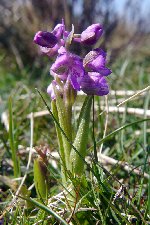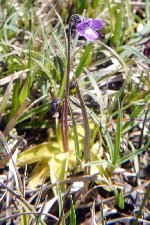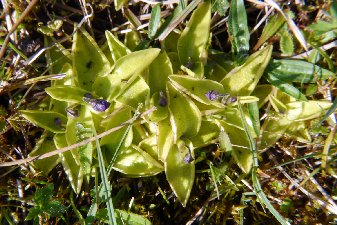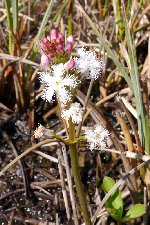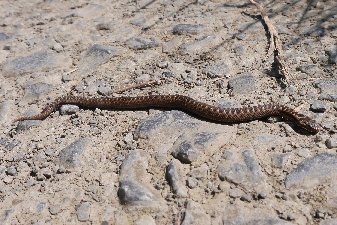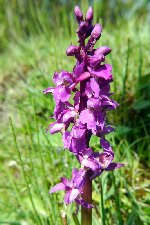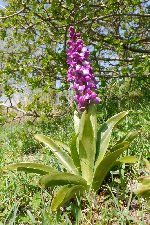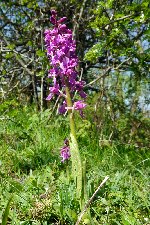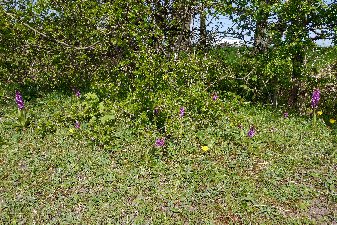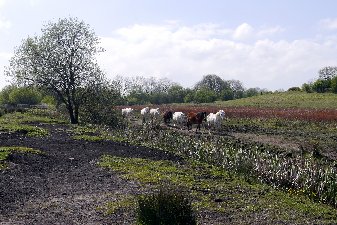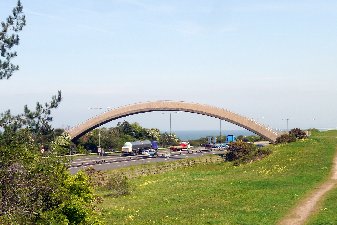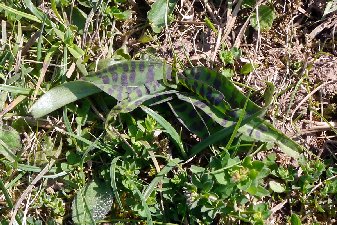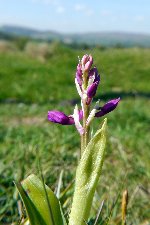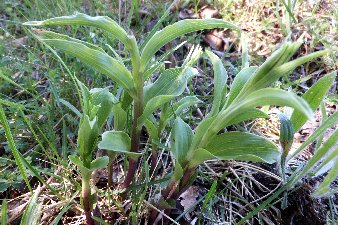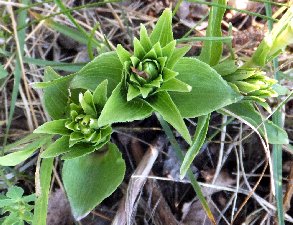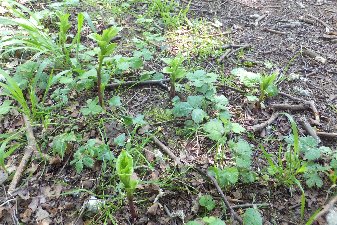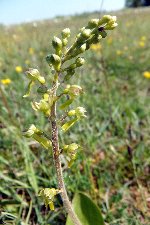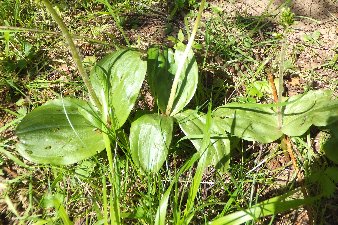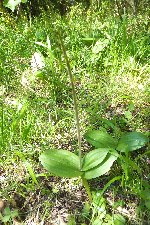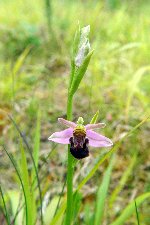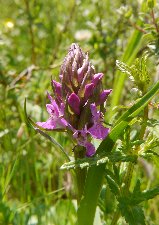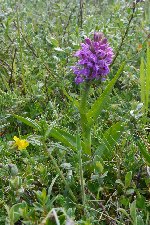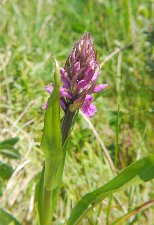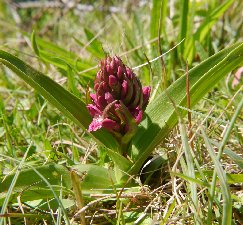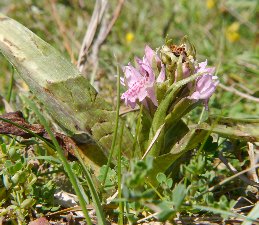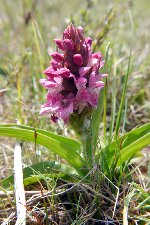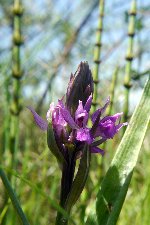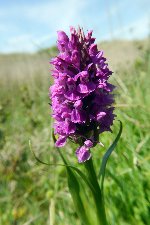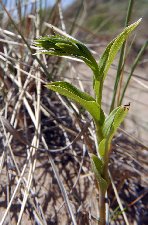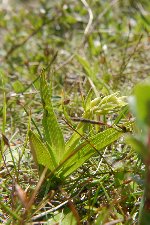|
|
|||||||||||||||||
|
|
|||||||||||||||||
 |
|
Cors Goch, 2nd May 2017 (SH502816) Nice sunny weather, not to hot and not too windy, for some time looking at the fens on Anglesey. For some unknown reason we have never been to Cors Goch before. This may be because it is not home to the Fly Orchid. But it is home to Green-winged Orchids, and this is a good time of year to see them. First however we came across the Early Purple Orchids; actually they were first encountered just at the entrance. We followed the marked paths in a clockwise direction and soon came to more of the same. After some fields we hit the fen proper, with springy boardwalks. No sign of any Marsh Orchids showing yet, so we decided not to walk the full extent of the reserve, It would double our time spent for little return, as it looked much of the same. Towards the end of the tour we climbed to the summit of low but steep-sided bump, and there at the top we finally came across the Green-winged Orchids. Not a large colony by any means with some range of variation. Colours ranged from pale pink to deep purple, with lip spotting from `freckles' to bold blots. They are all rather short reflecting the short turf in which they grow. Oddly, there was a track running across this orchid site, with GWO on one side and EPO on the other. It was here I found the day's oddity. A resupinate form of Early Purple. Actually it is more a semi-ruspinate form with some flowers upside down, and others at ninety degrees. It goes without saying that there were Common Spotted Orchid rosettes to be found easily.
Here I break from tradition and post some photos of plants other than orchids. Both here and the next fen had nice strong populations of Common Butterworts with flowers just opening, and Bog Beans, very impressive. And to cap it all we were pleased to find a juvenile adder sunning itself on the main drive as we left. Cors Bodeilio 2nd May 2017 (SH503775) I have been here several times before but never this early in the season. To be honest, I didn't really expect any findings, but there were some nice large Early Purple Orchids just off one side of the boardwalk. One group had a quite beefy example, with at least 13 leaves. Spotted leaves are not fashionable here. We might have gone further into the more soggy area, but a small flock of wild ponies were grazing there. These are probably left there to keep the scrub down and are taken away once the orchids start to get going. Their presence indicated that the season hadn't started and continuing would be a fruitless way of getting wet feet. May return in a few weeks perhaps.
The orchid in the second picture warrants some discussion; you can see it on the left hand side of the multiple orchid picture. It is a much `beefier' plant than the rest of the Early Purples, and the unspotted leaves are more erect, fleshier and numerous than you would expect for the species. The flower is very typical Early Purple ... apart from those rather erect lateral sepals. Does its size suggest that this is a polyploid example of the species or .... could it be a hybrid? Hybrid vigour and all that, though in height it is no taller than the larger EPOs, The leaves look Early Marsh Orchid, and there are plenty of these at the site. The odds are against this. The flowering times barely overlap, though both are pollinated by bumblebees. What are the chances of finding an unlisted inter-generic hybrid? Perhaps vegetative division could explain all the leaves, but with a single flower spike. But even considering it growing in open ground the leaves do not ring true for an EPO. As you approach Colwyn Bay on the A55 North Wales Expressway there is an arching footbridge over the dual carriageway. In July you can see Common Spotted Orchids in the grassland beneath the quarried cliffs on the landward side. There is access from a housing estate east of Old Colwyn, so we stopped to have a look. Nothing much to report except loads of Common Spotted rosettes in the turf. Nice diversion to take to spend a half hour or so. Halkyn Mountain is the high ground in N.E. Wales overlooking the Dee estuary. It is common land, used now for limestone quarrying and sheep grazing, and previously for lead mining. We have had one visit here previously which drew a blank, but I read that Green-winged orchids could be found above Halkyn village. A 90 minute search still only provided one solitary Early Purple Orchid not yet in full flower.
Then, for the second year running I manage to injure myself during May. This time I break my shoulder which means no driving for a while, and plans and immediate expectations are put hold for a year. Time to find some sites accessible by public transport after the operation. Alyn Waters Country Park. 25th May 2017 The rest of the country is filled with orchids in flower according to social media with some species up to a month ahead of a typical year, so hopefully there will be something to see here. It was not to be. The Bee Orchids are quite a way off flowering, and the Common Spotted Orchids are represented only by rosettes. Surprisingly the Green-flowered Helleborines in two of their best places are quite advanced and in good numbers, though this may be deceptive as they already show nibble damage. Common Twayblades abound, some in full flower and some still in bud. I found two Var trifolia growing close to each other, but this is possibly the tip of the iceberg considering the thousands of this species here. A quck drop in visit to see the state of play regarding the only orchid likely to be flower today. Just the one Bee Orchid to see with more to come hopefully. There were three close flower spikes but one in bud had already suffered slug damage. Ainsdale Dunes, 31st May 2017 (SD294120) We have been in this area several times before, but it has always been in late summer for the Helleborines growing on the woodland fringes; never in the early part of the year in the extensive dune system. These have much the same `look' as those at Sandscale - not surprising as they are part of the same coastline. We met wand chatted with the warden who told us that the orchids are only just coming into flower, but we did find some nice specimens even if there were no carpets of colour. First up were Northern and Southern Marsh Orchids. The warden said that the Dacts there freely hybridise, and despite the small numbers actually in flower we did see some evidence of this. The Early Marsh Orchids belied their name, seemingly quite late to flower in what is generally a early season year. Mostly they were represented by ssp. coccinea but pale pink ssp. incarnata could also be found. A careful inspection revealed numerous Marsh Helleborine rosettes, and even the occasional spike in bud. One other find was a small Dune Helleborine with developing flower spike - actually in the dunes and half a mile from its usual woodland habitat
|
|
|
|
|
